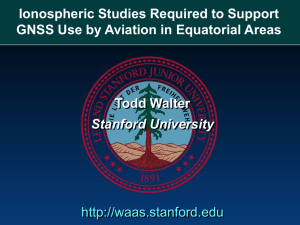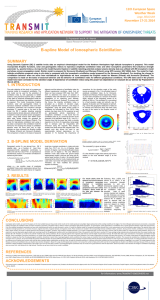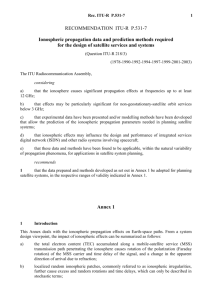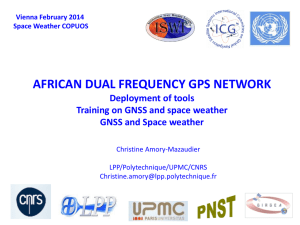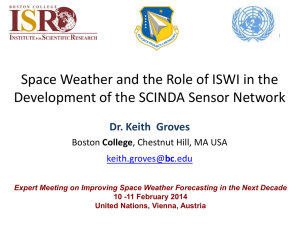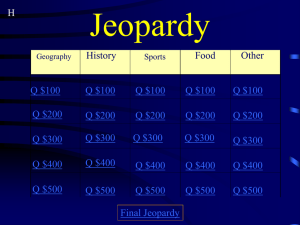Ionospheric scintillation and TEC studies over Brazil
advertisement
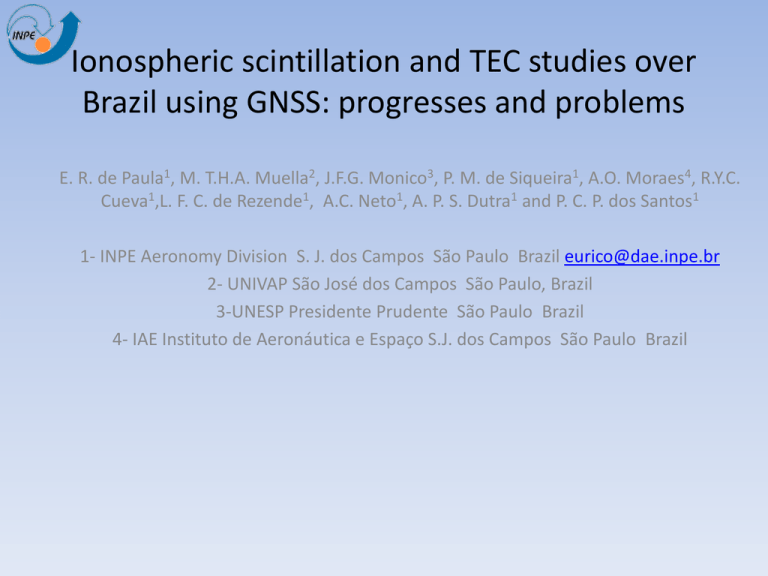
Ionospheric scintillation and TEC studies over Brazil using GNSS: progresses and problems E. R. de Paula1, M. T.H.A. Muella2, J.F.G. Monico3, P. M. de Siqueira1, A.O. Moraes4, R.Y.C. Cueva1,L. F. C. de Rezende1, A.C. Neto1, A. P. S. Dutra1 and P. C. P. dos Santos1 1- INPE Aeronomy Division S. J. dos Campos São Paulo Brazil eurico@dae.inpe.br 2- UNIVAP São José dos Campos São Paulo, Brazil 3-UNESP Presidente Prudente São Paulo Brazil 4- IAE Instituto de Aeronáutica e Espaço S.J. dos Campos São Paulo Brazil OUTLINE • GNSS networks at Brazil: SCINTMON(EURICO), LISN(EURICO/CESAR), CIGALA (Galera), RBMC/IBGE(Sonia Costa), SIPEG (Ícaro Vitorello) and IGS • S4 and TEC scientific studies • Scintillation effects over GNSS • Network operational problems • S4 calculations from different systems – each system has it own methodology to calculate S4 -> problem • Different models for absolute TEC calculation • Preliminar results from a campaign to study the behavior of different GNSS receivers during scintillation • Initiatives for scintillation prediction GPS receivers: (SCINTEC-CASCADE) INPE Receivers single L1 frequency MAGNETIC EQUATOR Belem-PA Belo Horizonte-MG Boa Vista-RR Brasilia-DF Cachoeira Paulista-SP Cuiabá-MT Manaus-AM Natal-RN Pato Branco-PR Presidente Prudente-SP Santa Maria-RS São João do Cariri-PB São José dos Campos-SP São Luís-MA Tefé-AM - Sample Rate: 50Hz GEC-PLESSEY Card INPE/CORNELL Zonal Velocity capability Amplitude Scintillation (S4) GPS stations in BRAZIL: (BLISN) CURRENT STATIONS - LISN LISN / NSF MAGNETIC EQUATOR Alta Floresta-MT Belo Horizonte-MG Boa Vista-RR Brasília-DF Cachoeira Paulista-SP Cuiabá-MT Dourados-MS Ilhéus-BA Imperatriz-MA Natal-RN Parintins-AM Pato Branco - PR Petrolina-PE Porto Velho-RO Rio Branco-AC Santa Maria-RS São Luís-MA São José dos Campos-SP São Gabriel da Cachoeira-AM Santarém-PA Tefé-AM - Sample rate: 50 Hz INPE/BC(NSF) TEC and S4 Novatel 4004 B (19) e Ashtech (2) RBMC/IBGE GNSS NETWORK - Dual Frequency receivers -> TEC - Contact Sonia Costa: sonia.alves@ibge.gov.br GNSS POSITIONING INTEGRATED SYSTEM FOR GEODYNAMIC STUDIES– SIPEG (Dr. Ícaro Vitorello) Stations in Operation and Predicted for 2012 Blue 09- Permanent Yellow 22- Temporarily Red 19- Predicted for 2012 Light blue 08-Permanent IBGE; 04 with tide gauges 03 with PTH sensor Dual Frequency 105 Trimble NET R8 -> TEC Contact Ícaro Vitorello: icaro@dge.inpe.br S4 AND TEC SCIENTIFIC STUDIES • Irregularity zonal velocity using cross-correlation methology with spaced GNSS receivers (Márcio Muella) • Irregularity (S4) and TEC morphology due to solar flux, local time, season, location • TEC behavior during magnetic storms • Influence of MSTIDs and GWs on the irregularity generation • SSW (Sudden Stratospheric Warming) effects over scintillation and TEC • TEC periodicities • Scintillation models (WAM, E. Costa/PUC, GIM( Yannick)) validation IRREGULARITY (S4) AND TEC MORPHOLOGY DUE TO SOLAR FLUX, LOCAL TIME, SEASON, LOCATION MAGNETIC STORMS: INHIBITED OR TRIGGER IONOSPHERIC SCINTILLATION Example of a case of storm triggered scintillation. Example of a case of storm inhibited scintillation . LOSS OF LOCK DUE TO SCINTILLATION Another lock loss Long period DGPS Loss of Signal in one petroleum drilling ship • Boa tarde, Gostaria de saber se é possível você me enviar algum dado referente a cintilação entre a noite do dia 19/09/2012 e a madrugada do dia 20/09/2012? Verificamos que tivemos uma perda de sinal de nossos sistemas DGPS e . gostariamos dessa informação Desde já agradeço o retordo Oficial de Náutica - Jansen Bridge Skandi Salvador Tel.: 55 + 22 2105-8358 Mob.: 55 + 21 7123-8252 Sat :+55 21 870 764 885927 www.norskan.com.br 11 DGPS Loss of Signal in one petroleum drilling ship-S4 from CIGALA Septentrio receiver on 09/19-20/2012 GENERAL PROBLEMS RELATED WITH GNSS NETWORKS/DATA ANALYSIS ETC - Lack of working people at the station Lack of training for these people Lack of daily remote station monitoring Lack of financial support for remore station maintenance: travels, local people, damaged equipment reposition Lack of financial support to purchase more receivers Old micros, receivers, antennas etc Lack of support to people at remote stations In many stations, mainly at Amazon region, there are frequent electrical power failures Low rate/failing Internet connections shared with many links Lightnings problems and lack of protection devices Multipath problems (normaly growing trees around the antennas) Firmware problems (LISN for instance almost 18 stations needs to be updated) Clock steering problem (LISN) Non access to some codes Loss of data in the recording medias/servers . . - CONSEQUENCE OF THESE PROBLEMS (FOR INSTANCE): - LISN: only 03 out of 21 are operational at the moment at Brazil SCINTEC/CASCADE: only 06 out of 20 are operational at the moment Models for absolute TEC calculation in use at INPE Nagoya-TECMAP (suitable for dense networks) UNB NOAA (US-TEC) MODION (UNESP) GI - Model DIFFERENT GPS RECEIVERS CAMPAIGN TO CHECK PERFORMANCE DURING SCINTILLATION (SEPTENTRIO, NOVATEL 4004B AND GPS STATION 6, ASTRA AND GEC-PLESSEY) DIFFERENT GPS RECEIVERS CAMPAIGN TO CHECK PERFORMANCE DURING SCINTILLATION (STANFORD SYSTEM – JUST ARRIVED) Prediction of ionospheric scintillation (L.F. C. de Rezende, 2009, Master Dissertation ) - Ionospheric scintillation prediction is also been developed at INPE using vertical plasma drift from digisonde data Thanks for the attention • References relative to this work: eurico@dae.inpe.br DGPS Loss of Signal in one petroleum drilling ship-S4 from CIGALA Septentrio receiver on 09/19/2012 IONOSPHERIC SCINTILLATION EFFECTS OVER GPS SIGNAL Dilution of precision (DOP) The expression “dilution of precision” (DOP) is used to name the effect of satellite geometry on the precision of navigation solution. Bad geometry Good geometry Measured decorrelation times fast scintillation (small 0) are associated with high S4 (Carrano and Groves, 2010) shows a histogram describing the overall distribution of the measured decorrelation times. The histogram was computed for the S4 intervals described above, and for 0 intervals that were 0.1 seconds wide. An important feature of Figure 7 is that most of the fast scintillation cases (small 0) are associated with strong amplitude scintillation, i.e., high S4. When S4 is greater than 0.7, the decorrelation time is generally less than 0.3 seconds. 22 GENERAL PROBLEMS RELATED WITH GNSS NETWORKS/DATA ANALYSIS ETC PROBLEMAS LOCAIS Na região amazônica: Energia elétrica de baixa qualidade com muitas oscilações. Nobreak e baterias são de extremas necessidades; Internet via radio de baixa velocidade (menos de 500 Kbps) compartilhada com todo o campus; Falta de dispositivo para proteção contra descargas atmosféricas, pois esta região tem registrado vários problemas com a falta destes dispositivos; A presença de arvores introduz ruídos nos sinais monitorados. Falta de pessoal com habilidades técnicas especificas. Nos demais locais, o principal problema é a falta de pessoas com habilidades técnicas especificas para atender a nossa demanda, e pratica de solicitação de favores não tem ajudado muito. Em algumas estações Lisn/Cascade precisamos trocar o computador e atualizar urgentemente o Firmware e scripts das estações remotas, mas não temos recursos para isto. Para as estações cascade, o principal problema está no software de monitoração, que por ter Cumulative Distribution Function of amplitude for 6 Dec 2001 STATION MAX MIN MEA MED STD São Luís 40.3 33.3 36.7 36.5 1.39 Cuiabá 43.5 23.7 37.9 38.0 1.73 São José dos 48.1 19.1 38.3 38.7 2.89 Campos Ionospheric scintillation and TEC studies over Brazil using GNSS: progresses and problems • • • • • • • • • • Ionospheric scintillation and TEC studies over Brazil using GNSS: progresses and problems E. R. de Paula1, M. T.H.A. Muella2, J.F.G. Monico3, P. M. de Siqueira1, A.O. Moraes4, R.Y.C. Cueva1,L. F. C. de Rezende1, A.C. Neto1, A. P. S. Dutra1 and P. C. P. dos Santos1 1- INPE Aeronomy Division S. J. dos Campos São Paulo Brazil eurico@dae.inpe.br 2- UNIVAP São José dos Campos São Paulo, Brazil 3-UNESP Presidente Prudente São Paulo Brazil 4- IAE Instituto de Aeronáutica e Espaço S.J. dos Campos São Paulo Brazil In this talk we present first the SCINTEC (INPE/Cornell GPS receiver network) amplitude scintillation, the BLISN (Brazilian Low-Latitude Ionospheric Sensor Network that provides amplitude and phase scintillation and TEC) and the BCIGALA (Brazilian CIGALA) characteristics. Following we will present the progresses including scientific studies and applications using the S4 and TEC data measured at those GNSS receiver networks over Brazil, a region with a large magnetic declination and with a large occurrence of ionospheric irregularities. Some cases of ionospheric irregularity effects over GNSS positioning are going to be reported. We also will report problems with GNSS network maintenance mainly at remote sites including their transmission using external networks, with data manipulation (availability management, filtering and storaging), with scintillation indices from different receivers, with different models such as UNB(Canada), STELAB-INPE(Nagoya), USTEC (NOAA), MODION (UNESP), GI (UTFPR) to estimate absolute TEC, S4 and TEC in almost real time mapping (nowcasting) and some trials to forecast scintillation. Finally some preliminar results from a campaign at INPE to study the behavior of different GNSS receivers under scintillation environment will be presented. The variability of amplitude scintillation patterns (Alison´s Phd) S4=0.9 Figure 4 shows four examples illustrating the variability in the decorrelation time computed from GPS L1 amplitude measurements made with very distinct 0 values: 0.94, 0.68, 0.43 and 0.18 seconds. This figure serves to exemplify the variability of amplitude scintillation patterns. The 0 value is defined as the time lag at which the autocorrelation function falls off by e-1 from its maximum (zero lag) value 26 SCINTILLATION AMPLITUDE DISTRIBUTIONS (ALISON’s Phd) Influence of MSTIDs and GWs on the irregularity generation (Ricardo´s PhD) Efeito do Ciclo Solar
